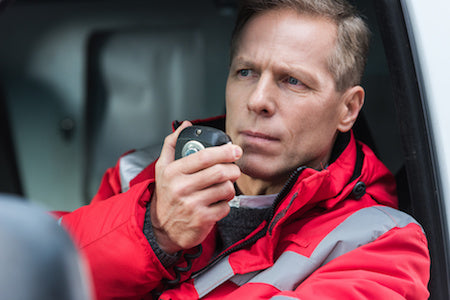In the case of a medical emergency, if you call 911 and ask for an ambulance, there are a lot of different first responders who might arrive on the scene. Some of these folks will have different training and certifications in emergency medical services, or EMS, and it can get a bit confusing to keep them straight.
This simple guide breaks down who does what when it comes to EMTs vs. paramedics and other first responders you may come across.
-
EMTs: Emergency medical technicians, or EMTs, are the most common emergency medical workers, trained in a wide variety of first-aid care. Most have undergone about 120 to 150 hours of hands-on training and coursework regulated by states and by the National Highway Traffic Safety Administration. They are certified to perform lots of common emergency treatments such as choking first aid, CPR, giving oxygen, administering glucose for diabetics, aiding in childbirth and some medication administration. There are different levels under the EMT umbrella that add different certifications. With few exceptions, EMTs are not certified to perform treatments that break the skin, which means no needles or injections.
-
Paramedics: Paramedics represent the highest level of emergency medical service providers. They have typically undergone 1,000 to 1,800 hours of training and can perform many more advanced treatments than an EMT. Skills include endotracheal intubation, fluid resuscitation, drug administration, IV placement, cardiac monitoring, manual defibrillation and more.
-
Police and firefighters: Police officers and firefighters are not necessarily required to have medical training, but in a medical emergency, they may be the first responders on the scene. Firefighters often arrive first because fire stations are strategically located, and police may simply be patrolling in a given area. It’s very common for firefighters and police to be trained in some medical treatments such as CPR, and many may be full EMTs.
-
Volunteers, or EMRs: Another group you should be aware of are the emergency medical responders, or EMRs, who volunteer across the United States, often through volunteer fire departments. These people typically have some certifications and general training in basic first aid, CPR and so on.
When it comes to choking, nearly all of these EMS providers should be trained to perform the common standards of care, which are back slaps and abdominal thrusts (also known as the Heimlich maneuver). It’s our goal that another treatment be added to that list: The Dechoker.
Our easy-to-use first-aid device has begun to save lives in nursing homes around the world, and we believe there should be a Dechoker in every ambulance and first response vehicle, as well. As much as we try to prevent choking emergencies, they will always still happen, particularly to vulnerable groups such as young children and elderly people. If we can’t prevent these emergencies, we can prepare for them by training our first responders how to use The Dechoker.
